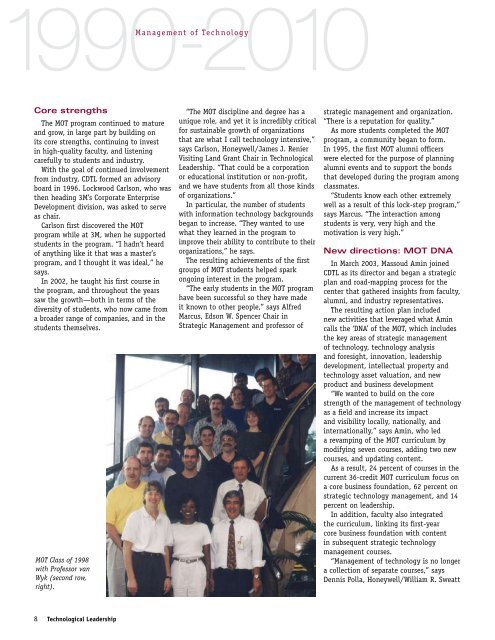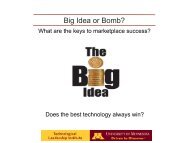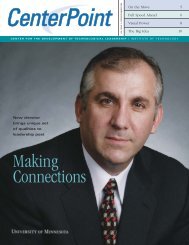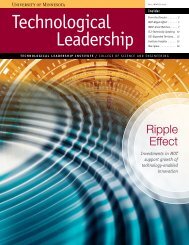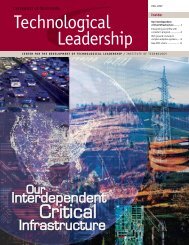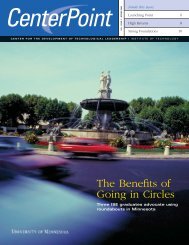Fall/Winter 2010 - Technological Leadership Institute - University of ...
Fall/Winter 2010 - Technological Leadership Institute - University of ...
Fall/Winter 2010 - Technological Leadership Institute - University of ...
- No tags were found...
You also want an ePaper? Increase the reach of your titles
YUMPU automatically turns print PDFs into web optimized ePapers that Google loves.
1990-<strong>2010</strong>Management <strong>of</strong> Technolog yCore strengthsThe MOT program continued to matureand grow, in large part by building onits core strengths, continuing to investin high-quality faculty, and listeningcarefully to students and industry.With the goal <strong>of</strong> continued involvementfrom industry, CDTL formed an advisoryboard in 1996. Lockwood Carlson, who wasthen heading 3M’s Corporate EnterpriseDevelopment division, was asked to serveas chair.Carlson first discovered the MOTprogram while at 3M, when he supportedstudents in the program. “I hadn’t heard<strong>of</strong> anything like it that was a master’sprogram, and I thought it was ideal,” hesays.In 2002, he taught his first course inthe program, and throughout the yearssaw the growth—both in terms <strong>of</strong> thediversity <strong>of</strong> students, who now came froma broader range <strong>of</strong> companies, and in thestudents themselves.MOT Class <strong>of</strong> 1998with Pr<strong>of</strong>essor vanWyk (second row,right).“The MOT discipline and degree has aunique role, and yet it is incredibly criticalfor sustainable growth <strong>of</strong> organizationsthat are what I call technology intensive,”says Carlson, Honeywell/James J. RenierVisiting Land Grant Chair in <strong>Technological</strong><strong>Leadership</strong>. “That could be a corporationor educational institution or non-pr<strong>of</strong>it,and we have students from all those kinds<strong>of</strong> organizations.”In particular, the number <strong>of</strong> studentswith information technology backgroundsbegan to increase. “They wanted to usewhat they learned in the program toimprove their ability to contribute to theirorganizations,” he says.The resulting achievements <strong>of</strong> the firstgroups <strong>of</strong> MOT students helped sparkongoing interest in the program.“The early students in the MOT programhave been successful so they have madeit known to other people,” says AlfredMarcus, Edson W. Spencer Chair inStrategic Management and pr<strong>of</strong>essor <strong>of</strong>strategic management and organization.“There is a reputation for quality.”As more students completed the MOTprogram, a community began to form.In 1995, the first MOT alumni <strong>of</strong>ficerswere elected for the purpose <strong>of</strong> planningalumni events and to support the bondsthat developed during the program amongclassmates.“Students know each other extremelywell as a result <strong>of</strong> this lock-step program,”says Marcus. “The interaction amongstudents is very, very high and themotivation is very high.”New directions: MOT DNAIn March 2003, Massoud Amin joinedCDTL as its director and began a strategicplan and road-mapping process for thecenter that gathered insights from faculty,alumni, and industry representatives.The resulting action plan includednew activities that leveraged what Amincalls the ‘DNA’ <strong>of</strong> the MOT, which includesthe key areas <strong>of</strong> strategic management<strong>of</strong> technology, technology analysisand foresight, innovation, leadershipdevelopment, intellectual property andtechnology asset valuation, and newproduct and business development“We wanted to build on the corestrength <strong>of</strong> the management <strong>of</strong> technologyas a field and increase its impactand visibility locally, nationally, andinternationally,” says Amin, who leda revamping <strong>of</strong> the MOT curriculum bymodifying seven courses, adding two newcourses, and updating content.As a result, 24 percent <strong>of</strong> courses in thecurrent 36-credit MOT curriculum focus ona core business foundation, 62 percent onstrategic technology management, and 14percent on leadership.In addition, faculty also integratedthe curriculum, linking its first-yearcore business foundation with contentin subsequent strategic technologymanagement courses.“Management <strong>of</strong> technology is no longera collection <strong>of</strong> separate courses,” saysDennis Polla, Honeywell/William R. Sweatt8 <strong>Technological</strong> <strong>Leadership</strong>


